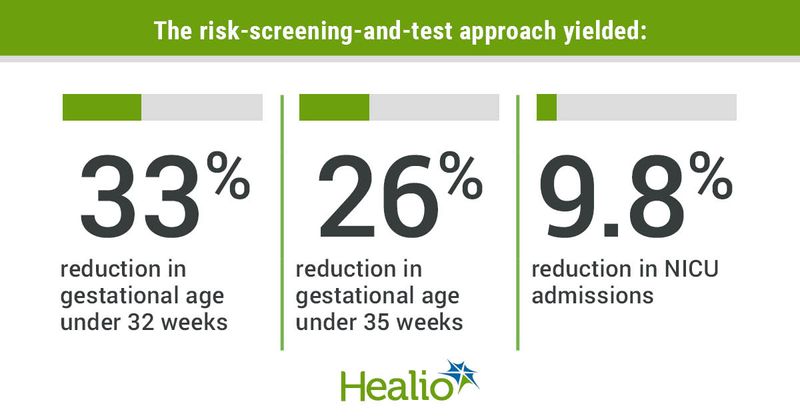Screenings, treatment strategies cost-effective ways to prevent preterm births
A novel screening technology combined with evidence-based treatment can prevent preterm births and save costs, according to a study published in ClinicoEconomics and Outcomes Research.
More than 10% of infants in the United States are born before 37 weeks gestation, the researchers said, presenting an increased risk for short-term and long-term health problems as well as increased health care costs.

Michael Grabner, PhD, MA, and colleagues at HealthCore Inc. further said that current prediction strategies only identify a minority of pregnant women who eventually experience preterm birth (PTB).
As an alternative, the researchers tested the use of a mass-spectrometry-based serum proteomics assay (PreTRM, Sera Prognostics) during the 19th or 20th week of pregnancy to predict PTBs.
The PreTRM test uses a ratio of insulin-like growth factor-binding protein 4 (IBP4) to sex hormone-binding globulin (SHBG) to predict the risk for PTB. An increase in IBP4 may signal uteroplacental insufficiency, whereas a decrease in SHBG may signal an infection or inflammation that can lead to the increased availability of free steroids that may promote labor.
The study follows previous research assessing PreTRM’s accuracy in predicting risks for spontaneous and medically indicated PTB. It began with a cohort of 62,093 live births in 2016.
Participating mothers had a mean age of 30.2 years (standard deviation, 5.1) when they gave birth. Also, 68% of the deliveries were vaginal births. Based on infant claims, overall PTB frequency was 7%.
During the 19th week of pregnancy, these women were placed into a cohort that followed usual care or into a cohort that involved a risk screening via the PreTRM test and follow-up treatment.
The test identified 15,570 mothers in the risk-screening-and-treat cohort as high risk. These mothers were offered established PTB prevention measures, including high-intensity case management (HCIM) and/or pharmacologic interventions from week 22 through week 36; 11,210 mothers selected such treatment and remained adherent.
HCIM included up to two additional visits to a maternal-fetal medicine specialist, up to two additional transvaginal ultrasounds and up to 10 additional nursing calls. Pharmacologic interventions included daily low-dose aspirin (81 mg) and daily vaginal progesterone (200 mg).
Women in the usual care cohort who were identified as high-risk received low-frequency use of progesterone, aspirin or other treatment.
Using base case treatment effectiveness assumptions, the researchers said that the risk-screening-and-test approach prevented 870 PTBs, or 20% of all PTBs in the cohort.
The risk-screening-and-treat cohort saw a 33% reduction in babies born with a gestational age under 32 weeks and a 26% reduction in gestational age under 35 weeks. It also yielded a 9.8% reduction in NICU admissions and a 20% reduction in length of NICU stays. Overall length of hospital stays for infants dropped by 7%. The proportion of infants with a neonatal medical index score greater than or equal to 3 — indicating severe morbidity or mortality — dropped by 23%.
The risk-screening-and-treat strategy cost $56 million in the weeks leading up to delivery. But the PTBs that the approach prevented would have cost $109 million, the researchers said, for a net savings of $54 million, or $863 per pregnant woman and $61,581 per prevented PTB.
“We did not consider quality of life (for mothers or infants) or long-term clinical sequelae, productivity, or other indirect costs, all of which may be substantially impacted by preterm birth,” the researchers wrote. “This is a conservative assumption likely to underestimate benefit of the risk-screening-and-treat strategy. Generating and incorporating appropriate data in this population would be an important task for future research.”
